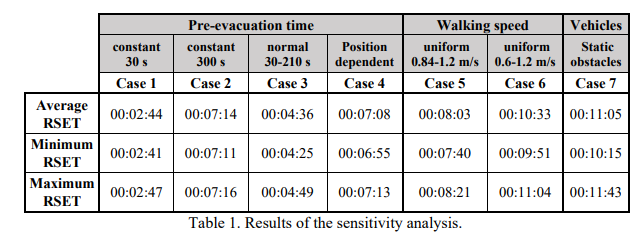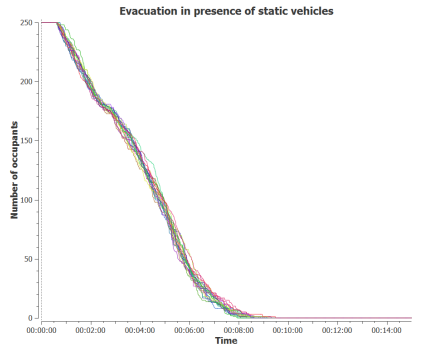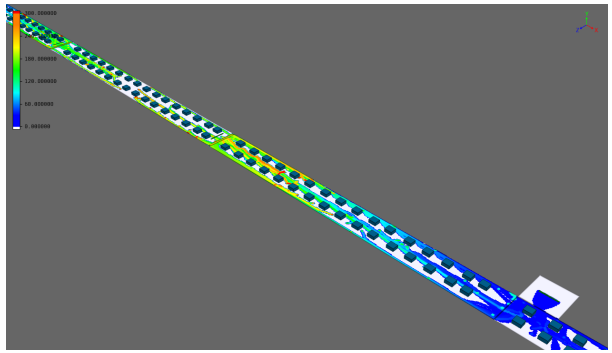2) Italian Fire Rescue and Service Ministry of Interior,
Rome, Italy
1) Sapienza University of Rome
Rome, Italy
Keywords
Road tunnels, evacuation modelling, sensitivity analysis, human behaviour, fire events
Human Behaviour in Road Tunnels
In order to reproduce through numerical models the emergency egress of people from road tunnels in case of critical events (such as fire, explosion, toxic release, etc.) several assumptions and approximations must be made on the human behaviour of drivers and passengers. Previous accidents [1] and, more recently, real drills (involving people in confined environments also in the presence of smoke effluents[2]) are the basis for understanding the peculiar dynamics of the evacuation naturally emerging after the occurrence of the critical event. Diffidence, low reaction time, reluctance of leaving their own car, bad behaviour of drivers are some of the recurrent features reported by rescuers and survivors [3]. Generally, the behaviour of drivers and passengers is hardly standardisable, considering that the population exposed is large, including people with different initial physical capabilities (elderly and young people), social behaviour (groups or independent drivers) and preparedness (previous training or experience).
Aim of the Study
This study aims to highlight the benefit of running evacuation simulations through a sensitivity analysis of the basic input parameters with MassMotion, developed and validated by Oasys (ARUP) [4]. Considering the absence of homogeneous characteristics of the occupants, providing a plausible estimation of the Required Safe Egress Time (RSET) is a very complicated issue because a large number of uncertainties must be dealt with. Predictions can be made but must be supported and validated by sensitivity analysis of the input parameters for the given tunnel.
Sensitivity Analysis
The sensitivity analysis is carried out in different steps. In all cases, only evacuation simulations are used, with no direct interaction with smoke effluents; however, considerations on backlayering and loss of visibility in proximity of the emergency exits will be also made. Moreover, considering that the occupants are randomly distributed in the domain and are characterised by input parameters assigned with probability distributions, for every case multiple runs are used in order to obtain average trends and deviations.
Firstly, fixing the geometry of the tunnel and the number of people determined by the queue of vehicles, the pre-evacuation time distribution is changed according to the literature review [5]. Four cases are analysed: for Case 1 and Case 2 fixed values, respectively 30 seconds and 300 seconds, are considered as reported by Purser [6] and ANAS (Italian government-owned company deputed to the construction and maintenance of motorways and state highways) [7], while for Case 3 and Case 4 a normal distribution between 30 and 210 seconds and a gradual decrease by approaching the critical event [8] are chosen. In all cases, walking speed is kept constant to 1.2 m/s.
Secondly, the effect of lower walking speed when large distances have to be covered is investigated: this might be the case of a severe fire accident, with backlayering in proximity of an emergency exit, but could also represents an existing tunnel with lack of means of egress. In the former case, in fact, the occupants might reduce their walking speed due to intoxication, whereas in the latter case the reduction might be due to physical effort due to coverage of large distance (several hundreds of meters) [5]. Starting from a constant walking speed of 1.2 m/s (Case 4), lower values are considered with uniform distribution varying between 0.84 and 1.2 m/s (Case 5) and 0.6 and 1.2 m/s (Case 6). For Case 5 and Case 6 the pre-evacuation time distribution is selected as in Case 4.
Then, the presence of vehicles as static obstructions is taken into account in the model (Case 7), with the aim of understanding if large differences in the RSET are expected or if their influence is limited to the evacuation paths (realistic and irregular rather than straight but unrealistic). In this case, pre-evacuation time distribution is like in Case 4 while walking speed is equal to that of Case 6.
Results
The results of the first part of the sensitivity analysis show that a pre-evacuation time distribution gradually decreasing by approaching the critical event (Case 4) seems the best option to model the varying level of alertness of the occupants, depending of their position in the tunnel. Other choices, such as constant values and normal distributions applied to all occupants, are analysed, but they do not replicate the overall phenomenon and seem a rough simplification. However, if one is focused only on the RSET, Case 2 and Case 4 provide similar results. Regarding the effect of walking speed, the analysis show that it is particularly important when long distances have to be covered, that is the case of tunnels not fulfilling the EU Directive requirement of the distance among means of egress, so it is recommended to use at least a uniform or normal distribution instead of a constant value.
References
1. Carvel, R. et al. Fires in vehicle tunnel. SFPE Handbook of Fire Prot. Engineering, Springer, 2015.
2. Frantzich, H., Nilsson, D. Evacuation experiments in a road tunnel: A study of Human Behaviour and technical installations. Fire Safety Journal 44, 2009, p458- p468, 2009.
3. Shields J. Human behaviour during tunnel fires. In: Carvel R, Beard A (eds) Handbook of Tunnel Fire Safety, 2nd edn. ICE Publishing, London, pp 399–420, 2012.
4. Zarnke M. MassMotion Flow Manual. Oasys Software Limited publishing, January 2015.
5. Ronchi E. A research roadmap for evacuation models used in fire safety engineering. Proceedings of Fire and Evacuation Modeling Technical Conference 2016.
6. Purser D. Application of human behaviour and toxic hazard analysis to the validation of CFD Modelling for the Mont Blanc Tunnel fire incident. Proceedings of the Fire Protection and Life Safety In Buildings and Transportation Systems Workshop 2009, Santander, SP, p23-p57, 2009.
7. Direzione Progettazione ANAS. Italian Guidelines for Road Tunnel Safety. 2nd edition, 2009. 8. Ronchi E. et al. Human behaviour in road tunnel fires: comparison between egress models (FDS+Evac, Steps, Pathfinder). Proceedings of 12th Interflam Conference, Nottingham, UK, 2010.
试用软件?
填写以下表格,我们的专家团队成员将与您联系
地点:北京市顺义区旭辉空港中心C栋518室
传真:010-61419525
联系电话:010-61419525
邮箱:info@yiguoyouxuan.com













